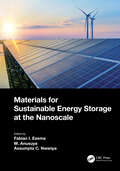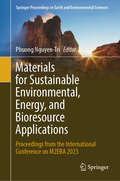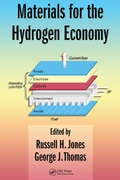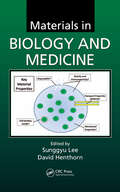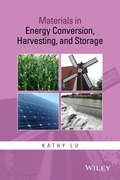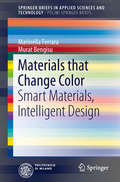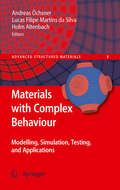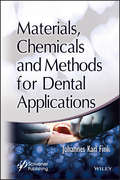- Table View
- List View
Materials for Sustainable Energy Storage at the Nanoscale
by Fabian I. Ezema M. Anusuya Assumpta C. NwanyaThe book Materials for Sustainable Energy Storage Devices at the Nanoscale anticipates covering all electrochemical energy storage devices such as supercapacitors, lithium-ion batteries (LIBs), and fuel cells,transformation and enhancement materials for solar cells, photocatalysis, etc. The focal objective ofthe book is to deliver stunning and current information to the materials application at nanoscale toresearchers and scientists in our contemporary time towardthe enhancement of energy conversion andstorage devices. However, the contents of the proposed book, Materials for Sustainable Energy Storageat the Nanoscale, will cover various fundamental principles and wide knowledge of different energyconversion and storage devices with respect to their advancement due to the emergence of nanoscalematerials for sustainable storage devices. This book is targeted to be award-winning as well as a referencebook for researchers and scientists working on different types of nanoscale materials-based energystorage and conversion devices. Features Comprehensive overview of energy storage devices, an important field of interest for researchers worldwide Explores the importance and growing impact of batteries and supercapacitors Emphasizes the fundamental theories, electrochemical mechanism, and its computational viewpoint and discusses recent developments in electrode designing based on nanomaterials, separators,and fabrication of advanced devices and their performances Fabian I. Ezema is a professor at the University of Nigeria, Nsukka. He earned a PhD in Physics and Astronomy from the University of Nigeria, Nsukka. His research focused on several areas of Materials Science, from synthesis and characterizations of particles and thin-film materials through chemical routes with emphasis on energy applications. For the last 15 years, he has been working on energy conversion and storage (cathodes, anodes, supercapacitors, solar cells, among others), including novel methods of synthesis, characterization and evaluation of the electrochemical and optical properties. He has published about 180 papers in various international journals and given over 50 talks at various conferences. His h-index is 21 with over 1500 citations and he has served as reviewer for several high impact journals and as an editorial board member. Dr. M.Anusuya, M.Sc., M.Phil., B.Ed., PhD is specialized in Material science, Thin Film Technology, Nano Science, and Crystallography. She is working as a Registrar of Indra Ganesan Group of Institutions, Trichy, Tamilnadu, India. Earlier to this, she served as a Vice-Principal at Trichy Engineering College, Trichy, Tamilnadu, India.. Being an administrator and teacher, with more than 25 years’ experience, for her perpetual excellence in academics she has been recognized with many awards. She has received over 45 awards in Academic and Social Activity. She has published more than 30 research papers in National and International journals, 7 chapters in edited books, 5 patents, presented 50 papers in the conferences and organized more than 200 webinars, both national and internationally. Dr Assumpta C. Nwanya is a Lecturer and a FLAIR (Future Leaders - African Independent Research) Scholar at the Department of Physics and Astronomy, University of Nigeria, Nsukka. She obtained her PhD in 2017 (University of Nigeria, Nsukka) with specialisation in the synthesis of nanostructured materials for applications in photovoltaics and electrochemical energy storage (batteries and supercapacitors) as well as for sensing. She was a Postdoctoral Fellow under the UNESCO-University of South Africa (UNISA) Africa Chair in Nanoscience and Nanotechnology (2018-2020). She is a research Affiliate with the SensorLab, University of the Western Cape Sensor Laboratories, Cape Town, South Africa. Dr Nw
Materials for Sustainable Environmental, Energy, and Bioresource Applications: Proceedings from the International Conference on M2EBA 2023 (Springer Proceedings in Earth and Environmental Sciences)
by Phuong Nguyen-TriThis proceedings book showcases the latest research and developments in materials sciences and their applications for solving environmental and energy-related challenges. The book features insightful contributions from leading researchers, academics, professionals, and students in the field, who share their expertise, experiences, and perspectives on the key issues and innovations in materials sciences and engineering. The book is helpful to those interested in environmental sustainability, energy efficiency, or bioresource utilization.
Materials for the Hydrogen Economy
by Russell H. Jones George J. ThomasHydrogen offers a promising alternative for supplying clean and sustainable energy to meet increasing demands worldwide. However, materials are key to transforming the technology into a viable industry. Materials for the Hydrogen Economy describes the technical challenges and the current efforts in developing materials possessing the properties req
Materials in Biology and Medicine (Green Chemistry and Chemical Engineering)
by Sunggyu Lee David HenthornWhile the interdisciplinary field of materials science and engineering is relatively new, remarkable developments in materials have emerged for biological and medical applications, from biocompatible polymers in medical devices to the use of carbon nanotubes as drug delivery vehicles. With peer-reviewed chapters written by a select group of academic and industry experts, this comprehensive yet accessible book covers the most advanced materials used in biology and medicine. The book focuses on biomaterials and bioinspired materials, functional and responsive materials, controlling biology with materials, and the development of devices and enabling technologies. It will help readers tackle challenges of novel materials, carry out new process and product development projects, and create new methodologies for applications that enhance the quality of life.
Materials in Energy Conversion, Harvesting, and Storage
by Kathy LuFirst authored book to address materials' role in the quest for the next generation of energy materials Energy balance, efficiency, sustainability, and so on, are some of many facets of energy challenges covered in current research. However, there has not been a monograph that directly covers a spectrum of materials issues in the context of energy conversion, harvesting and storage. Addressing one of the most pressing problems of our time, Materials in Energy Conversion, Harvesting, and Storage illuminates the roles and performance requirements of materials in energy and demonstrates why energy materials are as critical and far-reaching as energy itself. Each chapter starts out by explaining the role of a specific energy process in today's energy landscape, followed by explanation of the fundamental energy conversion, harvesting, and storage processes. Well-researched and coherently written, Materials in Energy Conversion, Harvesting, and Storage covers: The availability, accessibility, and affordability of different energy sources Energy production processes involving material uses and performance requirements in fossil, nuclear, solar, bio, wind, hydrothermal, geothermal, and ocean energy systems Issues of materials science in energy conversion systems Issues of energy harvesting and storage (including hydrogen storage) and materials needs Throughout the book, illustrations and images clarify and simplify core concepts, techniques, and processes. References at the end of each chapter serve as a gateway to the primary literature in the field. All chapters are self-contained units, enabling instructors to easily adapt this book for coursework. This book is suitable for students and professors in science and engineering who look to obtain comprehensive understanding of different energy processes and materials issues. In setting forth the latest advances and new frontiers of research, experienced materials researchers and engineers can utilize it as a comprehensive energy material reference book.
Materials in Mechanical Extremes
by Neil BourneThis unified guide brings together the underlying principles, and predictable material responses, that connect metals, polymers, brittle solids and energetic materials as they respond to extreme external stresses. Previously disparate scientific principles, concepts and terminology are combined within a single theoretical framework, across different materials and scales, to provide all the tools necessary to understand, and calculate, the responses of materials and structures to extreme static and dynamic loading. Real-world examples illustrate how material behaviours produce a component response, enabling recognition - and avoidance - of the deformation mechanisms that contribute to mechanical failure. A final synoptic chapter presents a case study of extreme conditions brought about by the infamous Chicxulub impact event. Bringing together simple concepts from diverse fields into a single, accessible, rigourous text, this is an indispensable reference for all researchers and practitioners in materials science, mechanical engineering, physics, physical chemistry and geophysics.
Materials that Change Color
by Marinella Ferrara Murat BengisuThis book presents a design-driven investigation into smart materials developed by chemists, physicists, materials and chemical engineers, and applied by designers to consumer products. Introducing a class of smart materials, that change colors, the book presents their characteristics, advantages, potentialities and difficulties of applications of this to help understanding what they are, how they work, how they are applied. The books also present a number of case studies: products, projects, concepts and experiments using smart materials, thus mapping out new design territories for these innovative materials. These case studies involve different fields of design, including product, interior, fashion and communication design. Within the context of rising sustainable and human-centered design agendas, the series will demonstrate the role and influence of these new materials and technologies on design, and discuss how they can implement and redefine our objects and spaces to encourage more resilient environments.
Materials that Move: Smart Materials, Intelligent Design (SpringerBriefs in Applied Sciences and Technology)
by Marinella Ferrara Murat BengisuThis book presents a design-driven investigation into smart materials developed by chemists, physicists, materials and chemical engineers, and applied by designers to consumer products, buildings, interfaces, or textiles. Introducing a class of smart materials (referred to as stimuli-responsive, morphing or kinetic materials) that move and change their shape in response to stimuli, the book presents their characteristics, advantages, potentials, as well as the difficulties involved in their application. The book also presents a large number of case studies on products, projects, concepts, and experiments employing smart materials, thus mapping out new design territories for these innovative materials. The case studies involve different fields of design, including product, interior, fashion, and communication design. Reflecting the growing demand for sustainable and human-centered design agendas, the book explores and reveals the role and influence of these new materials and technologies on design and human experience, and discusses how they can be used to redefine our objects and spaces so as to promote more resilient environments. The book offers an intriguing and valuable resource for design professionals, engineers, scientists and students alike.
Materials with Complex Behaviour
by Lucas F. Silva Holm AltenbachThe increasing demand for materials with superb properties in all types of technical applications requires the development of advanced materials and respective tools to characterise and predict the material properties and behaviour. This monograph highlights the latest developments and trends in advanced materials and their properties, the modelling and simulation of non-classical materials and structures, and new technologies for joining materials.
Materials with Internal Structure
by Patrizia TrovalusciThe book presents a series of concise papers by researchers specialized in various fields of continuum and computational mechanics and of material science. The focus is on principles and strategies for multiscale modeling and simulation of complex heterogeneous materials, with periodic or random microstructure, subjected to various types of mechanical, thermal, chemical loadings and environmental effects. A wide overview of complex behavior of materials (plasticity, damage, fracture, growth, etc. ) is provided. Among various approaches, attention is given to advanced non-classical continua modeling which, provided by constitutive characterization for the internal and external actions (in particular boundary conditions), is a very powerful frame for the gross mechanical description of complex material behaviors, able to circumvent the restrictions of classical coarse-graining multiscale approaches.
Materials, Chemicals and Methods for Dental Applications
by Johannes Karl FinkThis book focuses on the materials used for dental applications looking at the fundamental issues and the developments that have taken place the past decade. While it provides a broad overview of dental materials, the chemicals that are used for the preparation and fabrication of dental materials are explained as well. Also, the desired properties of these materials are discussed and the relevance of the chemical, physical, and mechanical properties is elucidated. Methods for the characterization and classification, as well as clinical studies are reviewed here. In particular, materials for dental crowns, implants, toothpaste compositions, mouth rinses, as well as materials for toothbrushes and dental floss are discussed. For example, in toothpaste compositions, several classes of materials an chemcials are incorporated, such as abrasives, detergents, humectants, thickeners, sweeteners, coloring agents, bad breath reduction agents, flavoring agents, tartar control agents, and others. These chemicals, together with their structures, are detailed in the text.
Materials, Devices and Systems for Sustainability (IITK Directions #8)
by Laltu Chandra Sudarshan Narayanan Deepika JhajhriaThis book explores groundbreaking advancements in science and technology aimed at creating a sustainable future. It covers key innovations in renewable energy, clean hydrogen production, next-generation energy storage, carbon capture, and resilient infrastructure. The first section examines materials for a sustainable ecosystem, viz. solar energy harvesting and storage, including methods to improve perovskite solar cells, solar thermal-based ammonia cracking, challenges in commercializing solid-state electrolyte batteries, and S-scheme heterojunctions for efficient photocatalysis. Herein, the book also proposes a novel framework integrating mobile microgrids into power distribution networks to enhance resilience in the context of RE integration. It then shifts to devices and methods for achieving low-carbon industrial processes, discussing molten catalytic systems and CO2 capture via engineered biochar. Beyond technology, the book then addresses India's renewable energy policies and the need for zero-carbon steel, exploring carbon capture solutions for the steel and cement industries, while also highlighting the necessity for energy transition modelling. With a blend of scientific insights and policy recommendations, this book serves as a valuable resource for researchers, policymakers, and anyone interested in driving sustainable progress.
Materials, Structures and Manufacturing for Aircraft (Sustainable Aviation)
by Melih Cemal Kuşhan Selim Gürgen Mehmet Alper SofuoğluThis book offers a comprehensive look at materials science topics in aerospace, air vehicle structures and manufacturing methods for aerospace products, examining recent trends and new technological developments. Coverage includes additive manufacturing, advanced material removal operations, novel wing systems, design of landing gear, eco-friendly aero-engines, and light alloys, advanced polymers, composite materials and smart materials for structural components. Case studies and coverage of practical applications demonstrate how these technologies are being successfully deployed. Materials, Structures & Manufacturing for Aircraft will appeal to a broad readership in the aviation community, including students, engineers, scientists, and researchers, as a reference source for material science and modern production techniques.
Materialwissenschaft und Werkstofftechnik: Physikalische Grundlagen
by Günter Gottstein Sandra Korte-KerzelDieses Lehrbuch führt interessierte Leserinnen und Leser in die modernen Konzepte der physikalischen Metallkunde und Materialphysik ein. Diese sind gleichermaßen grundlegend für das Verständnis metallischer sowie nichtmetallischer Werkstoffe und bilden daher die Grundlagen der Materialwissenschaft und Werkstofftechnik über alle klassischen Werkstoffklassen der Metalle, Keramiken, Gläser und Kunststoffe hinweg. Im Mittelpunkt steht dabei der naturwissenschaftliche Aspekt, ohne dass die ingenieurwissenschaftliche Sichtweise und der Blick auf technische Anwendungen vernachlässigt wird. Die vorliegende Auflage enthält eine kurze Übersicht moderner Charakterisierungsmethoden und wurde um ein Kapitel zur Bruchmechanik ergänzt. Neue didaktische Elemente, wie Kurzzusammenfassungen am Ende der Kapitel und englische Übersetzungen zentraler Begriffe, sollen das Nachschlagen und Wiederholen des Stoffes sowie den Einstieg in die internationale Literatur erleichtern.
Materiomics: High-throughput Screening of Biomaterial Properties
by Jan De Boer Clemens A. van BlitterswijkThis complete, yet concise, guide introduces you to the rapidly developing field of high throughput screening of biomaterials: materiomics. Bringing together the key concepts and methodologies used to determine biomaterial properties, you will understand the adaptation and application of materomics in areas such as rapid prototyping, lithography and combinatorial chemistry. Each chapter is written by internationally renowned experts, and includes tutorial paragraphs on topics such as biomaterial-banking, imaging, assay development, translational aspects, and informatics. Case studies of state-of-the-art experiments provide illustrative examples, whilst lists of key publications allow you to easily read up on the most relevant background material. Whether you are a professional scientist in industry, a student, or a researcher, this book is not to be missed if you are interested in the latest developments in biomaterials research.
Maternal Effects in Mammals
by Dario Maestripieri Jill M. MateoEvolutionary maternal effects occur whenever a mother's phenotypic traits directly affect her offspring's phenotype, independent of the offspring's genotype. Some of the phenotypic traits that result in maternal effects have a genetic basis, whereas others are environmentally determined. For example, the size of a litter produced by a mammalian mother--a trait with a strong genetic basis--can affect the growth rate of her offspring, while a mother's dominance rank--an environmentally determined trait--can affect the dominance rank of her offspring. The first volume published on the subject in more than a decade,Maternal Effects in Mammalsreflects advances in genomic, ecological, and behavioral research, as well new understandings of the evolutionary interplay between mothers and their offspring. Dario Maestripieri and Jill M. Mateo bring together a learned group of contributors to synthesize the vast literature on a range of species, highlight evolutionary processes that were previously overlooked, and propose new avenues of research. Maternal Effects in Mammalswill serve as the most comprehensive compendium on and stimulus for interdisciplinary treatments of mammalian maternal effects.
Maternal Hemodynamics
by Christoph Lees Wilfried GyselaersDiscover new concepts in cardiovascular and hemodynamic functionality during pregnancy, with international experts in feto-maternal medicine. During the early stages of pregnancy, the maternal heart and circulation are subject to major gestational adaptive changes that allow for a normal course and outcome for both mother and baby. Any disruption to these processes can precipitate the onset of severe maternal and fetal complications such as preeclampsia, or intrauterine growth restriction. This invaluable reference work provides a comprehensive discussion of each aspect of the circulation. With a focus on the physiologic and pathophysiologic aspects of maternal cardiovascular function, this guide supports non-invasive assessment, management and prevention techniques for cardiovascular disease, for all stages of fetal and neonatal life. This text supports researchers and specialists in maternal-fetal medicine, whilst providing a key grounding in the topic, for trainees wishing to be at the cutting edge of theories and research.
Maternal and Infant Deaths: Chasing Millennium Development Goals 4 and 5
by Sean Kehoe James P Neilson Jane E NormanMillennium Development Goals (MDGs) 4 and 5, created under the auspices of the United Nations, challenged political, financial, medical and civil society leaders to improve both child and maternal health. The 58th RCOG Study Group brought together a range of experts - including midwives, obstetricians and gynaecologists, anaesthetists and paediatricians - to provide an up-to-date review of progress to date and the challenges around meeting these MDGs. This book presents the findings of the Study Group, with sections covering: - the size of the problem - clinical problems and solutions - maternal - clinical problems and solutions - neonatal - training and development - specific challenges in specific countries (Afghanistan, Zimbabwe, Egypt and Sri Lanka).
Math 100 Ideas in 100 Words: A Whistle-stop Tour of Science’s Key Concepts
by DKGet to grips with the essential topics in maths today through 100 key ideas, each one explained clearly in 100 words.Math: 100 Ideas in 100 Words offers the essential facts at your fingertips, satisfying your mathematical curiosity and helping you to understand the biggest concepts in math in concise, 100-word summaries. One of the first titles in a cutting-edge new series created in partnership with The Science Museum, this book introduces 100 key areas of math such as geometry, algebra, probability and pure math, and explains each topic in just 100 words. Perfect for getting your head around big ideas clearly and quickly, or refreshing your memory of the fundamentals of math, this book covers the most up-to-date terms and theories and inspires a heightened level of understanding and enjoyment to the core areas of math.
Math Maker Lab: 27 Super Cool Projects (DK Activity Lab)
by DKA fun and engaging STEM activity book for kids that combines creativity and calculations - perfect for budding mathematicians!This is the perfect math exercise book for children interested in the STEM field. Choose between 27 creative projects and experiments that will turn your child into a math whizz! It's the perfect book for curious minds interested in taking the mystery out of math. Explore the exciting world of numbers and math problem-solving! In the pages of this math book for kids you&’ll discover: • 27 hands-on creative projects to engage reluctant mathematicians between the ages of 9-12 • Easy-to-follow step-by-step instructions will show you how to make each project • All materials used can be easily found around your home with no specialist equipment needed • Every project includes an explanation of how math is involved in creating the project or the results of the experiment • Real-world math projects show that math isn&’t just abstract - it has an impact in the real world too! Produced in conjunction with the Smithsonian Institution, SI Math Maker Lab is designed to appeal to math geeks and those that prefer practical projects. To complete these engaging projects, kids don&’t need to be math geniuses or even know how to use a calculator. Each task comes with easy-to-follow instructions, photographs, and illustrations to help whip up super cool mathematics creations!SI Math Maker Lab features interesting activities that cover many aspects of the subject including measurement, geometry, and trigonometry. Kids will combine art and math by learning to draw impossible objects - creating beautiful patterns to make things like a timetable dreamcatcher or perfect the ratio for making refreshing fruit drinks. Each project has an explanatory box that demonstrates how math is applied to the activity to demystify and make math fun!
Math Makers: The Lives and Works of 50 Famous Mathematicians
by Alfred S. Posamentier Christian SpreitzerAn entertaining history of mathematics as chronicled through fifty short biographies. Mathematics today is the fruit of centuries of brilliant insights by men and women whose personalities and life experiences were often as extraordinary as their mathematical achievements. This entertaining history of mathematics chronicles those achievements through fifty short biographies that bring these great thinkers to life while making their contributions understandable to readers with little math background. Among the fascinating characters profiled are Isaac Newton (1642-1727), the founder of classical physics and infinitesimal calculus—he frequently quarreled with fellow scientists and was obsessed by alchemy and arcane Bible interpretation; Sophie Germain (1776 - 1831), who studied secretly at the Ecole Polytechnique in Paris, using the name of a previously enrolled male student—she is remembered for her work on Fermat's Last Theorem and on elasticity theory; Emmy Noether (1882 - 1935), whom Albert Einstein described as the most important woman in the history of mathematics—she made important contributions to abstract algebra and in physics she clarified the connection between conservation laws and symmetry; and Srinivasa Ramanujan (1887-1920), who came from humble origins in India and had almost no formal training, yet made substantial contributions to mathematical analysis, number theory, infinite series, and continued fractions. The unusual behavior and life circumstances of these and many other intriguing personalities make for fascinating reading and a highly enjoyable introduction to mathematics.
Math Teacher's Survival Guide: Practical Strategies, Management Techniques, and Reproducibles for New and Experienced Teachers, Grades 5-12
by Muschla Judith A. Gary Robert Erin MuschlaClassroom-tested strategies to help new and experienced math teachers thrive Math teachers must not only instruct their students in basic mathematical skills and concepts, they must also prepare them for standardized tests, provide instruction in the use of technology, and teach problem-solving and critical-thinking skills. At the same time, they must also manage their other responsibilities - taking attendance, planning, grading, record-keeping, disciplining, and communicating with parents and administrators. This book provides efficient and practical information on the management skills necessary to succeed in this most challenging profession. Offers realistic suggestions and strategies for planning and delivering effective math instruction Helps math teachers achieve excellence and continue to be enthusiastic and successful in their teaching careers Includes reproducible forms to help math teachers stay on top of everything they need to do The Math Teacher's Survival Guide contains a wealth of useful tools and strategies that can help any math teacher succeed in the classroom.
Math and Science Investigations: Helping Young Learners Make Big Discoveries
by The Vermont Center for the Book Sally AndersonChildren's books and hands-on investigations bring math and science concepts to life! Young children are naturally interested in the patterns and processes occurring in the world around them. They are beginning to learn about the changes happening each day, month, and season. They are starting to ask questions about the environment and world beyond. They are anxious to explore the creatures in their own backyard.Math and Science Investigations supports young children's natural curiosity and encourages them to explore what happens around them. Hands-on investigations help children learn the skills, concepts, and standards of mathematics, science, language, and literacy - all at the same time - using some of their favorite books. Themes include: Exploring Spaces (and Places!); What Comes Next?; Out and About; and Growing and Changing.Each investigation includes: * General introduction to the theme * Ideas to start you thinking about math, science, language, and literacy * Vocabulary related to the topic * Children's book suggestions
Math and Science for Young Children
by Rosalind CharlesworthMATH AND SCIENCE FOR YOUNG CHILDREN, Eighth Edition, is an introduction to engaging math and science experiences for early childhood and early elementary education programs, and provides an organized, sequential approach to creating a developmentally appropriate math and science curriculum.
Math for Scientists: Refreshing the Essentials
by Natasha Maurits Branislava Ćurčić-BlakeThis book reviews math topics relevant to non-mathematics students and scientists, but which they may not have seen or studied for a while. These math issues can range from reading mathematical symbols, to using complex numbers, dealing with equations involved in calculating medication equivalents, the General Linear Model (GLM) used in e.g. neuroimaging analysis, finding the minimum of a function, independent component analysis, or filtering approaches. Almost every student or scientist, will at some point run into mathematical formulas or ideas in scientific papers that may be hard to understand, given that formal math education may be some years ago. In this book we will explain the theory behind many of these mathematical ideas and expressions and provide readers with the tools to better understand them. We will revisit high school mathematics and extend and relate this to the mathematics you need to understand the math you may encounter in the course of your research. This book will help you understand the math and formulas in the scientific papers you read. To achieve this goal, each chapter mixes theory with practical pen-and-paper exercises such that you (re)gain experience with solving math problems yourself. Mnemonics will be taught whenever possible. To clarify the math and help readers apply it, each chapter provides real-world and scientific examples.In this new edition, two new chapters covering statistics and differential equations have been added, which have been workshopped in the 'authors' popular lecture series in order to maximize the benefit for readers.
